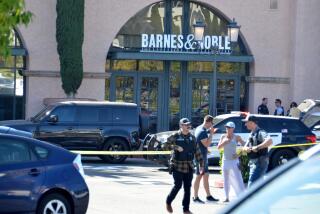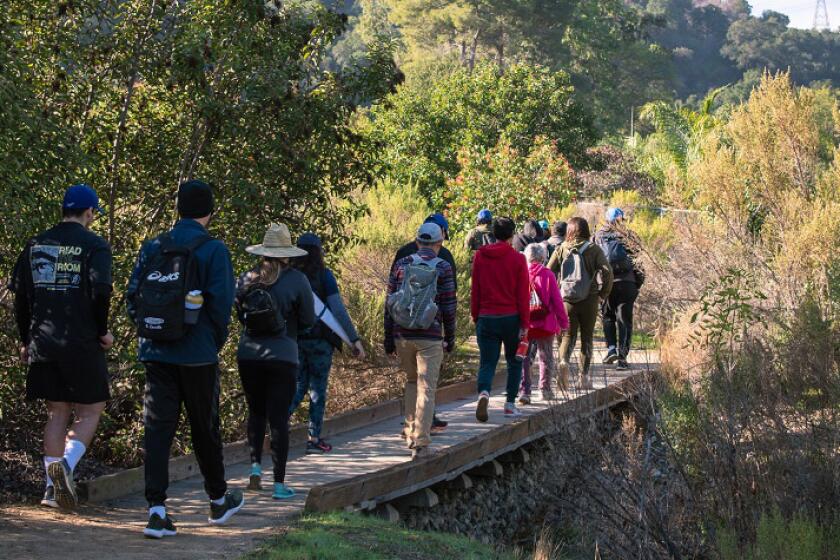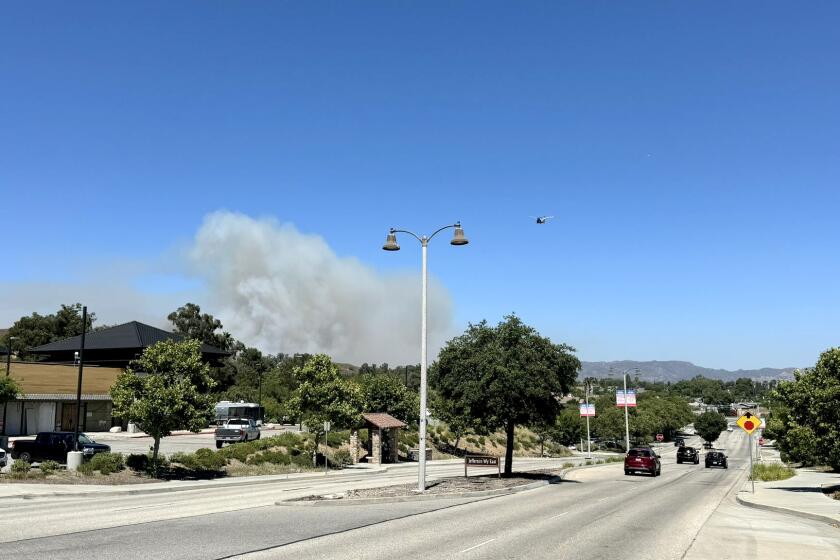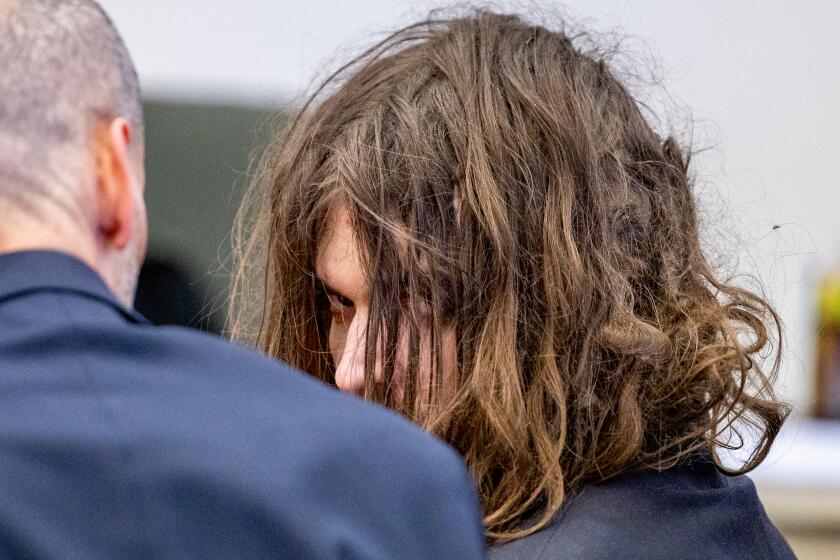Chief Parker Molded LAPD Image--Then Came the ‘60s : Police: Press treated officers as heroes until social upheaval prompted skepticism and confrontation.
He came to power after the latest in a seemingly unending series of police scandals--high-ranking LAPD officers had been indicted for providing protection for a notorious local madam with Mafia connections--and he came with an unprecedented mandate. Armed with City Charter and Civil Service protection not enjoyed by most of his predecessors, Police Chief William H. Parker vowed to clean up the Los Angeles Police Department--and clean it up he did.
Occasional scandals still occurred--including the “Bloody Christmas” beating of seven prisoners in 1951. But the Los Angeles media loved the LAPD unconditionally in those days so--typically--early newspaper stories reported only an attack against the police, not the ensuing beating by the police; the first Times headline said “Officers Beaten in Bar Brawl; Seven Men Jailed.”
Parker initially denied charges of police brutality and accused critics of trying to discredit the department. He later launched an intensive investigation. The chief ultimately transferred 54 officers--including two deputy chiefs--and suspended 39 others. A grand jury indicted eight officers for felonious assault; five were convicted.
Parker’s message got through, and almost overnight, it seemed, he had made the LAPD the most professional, corruption-free police force in the country. The department went from local disgrace to national fame--a crisp, militaristic “thin blue line” (a phrase Parker coined) admired and emulated from coast to coast as it struggled valiantly to protect civilized society from godless communists, murderous thugs and the widespread dangers and decay of modern urban life.
Given access and approval by Parker--after some initial skepticism--Jack Webb and his “Dragnet” television show helped polish the LAPD’s image further, as did Parker’s own television show--called “The Thin Blue Line”--and the department’s press office, created by Parker in 1956.
Parker was very sophisticated about the media. Lt. Dan Cooke, longtime LAPD spokesman before his retirement in 1988, recalls several instances when television reporters would tell Parker they wanted “a minute or two” with the chief on camera, “and Parker would say, ‘Well, which is it--one or two?’ Then he’d go off the top of his head and stop at two minutes on the button.”
The combination of Webb and Parker--and the blunt-spoken, media savvy ways of subsequent LAPD Chiefs Ed Davis and Daryl F. Gates--largely explain why the Los Angeles County Sheriff’s Department, which employs more people and covers a larger area than the LAPD, has never had the cachet or the media attention, good and bad, that has long been focused on the LAPD. With no sheriff’s equivalent of “Dragnet” and with comparatively bland leaders dating back 60 years, the sheriff’s office has generally been the neglected stepchild of media scrutiny.
Parker was never neglected.
Indeed, for most of his reign, the media treated him--and his department--like heroes. After all, for the media in the 1950s and early 1960s, police stories were still essentially crime stories, and Parker had built the best crime-fighting force around.
To many, Parker’s baronial autonomy--and the often idolatrous coverage that the media gave him--helped foster conditions that ultimately made the Rodney G. King beating and the ensuing riots possible, if not inevitable.
There is a “lineage--a direct line” between Parker and the King case, says Ron Kaye, assistant managing editor at the Daily News, who, like everyone else interviewed for today’s story, spoke before the verdicts in the King case and the three days of rioting that followed.
It was Parker who began the department’s “proactive” approach to policing. Unlike police in many other big cities, LAPD officers do not sit around doughnut shop parking lots in patrol cars waiting for the next radio call; they cruise the streets, looking for trouble before it happens, trying to spot possible criminals by their appearance and their demeanor, determined to do unto them before they can do unto anyone else.
As the Christopher Commission would find out 40 years later, that often meant hassling young black males--innocent black males.
This problem was not unique to Los Angeles, of course. An 11-city study by Peter Rossi at Johns Hopkins University in 1968 showed that because “the urban lower class is today disproportionately black . . . a dark skin is to the police a statistically significant cue to social status and thus to potential criminality.”
But the proactive approach of the LAPD has probably made officers even more likely to act aggressively on that cue here than elsewhere.
The McCone Commission, appointed to investigate the 1965 Watts riots, said “a resentment, even hatred, of the police (was) a fundamental cause for the riot.” But the “widely shared” view among blacks in Los Angeles that they were “at the mercy of bigoted police” had been reported two years earlier by the California Advisory Committee to the U.S. Civil Rights Commission. The media paid relatively little attention to the report--or, before Watts, to the entire issue of LAPD behavior in South Los Angeles.
Parker made, with relative impunity, several statements that were at least as offensive to minorities as statements that Chief Gates would be excoriated for in later years.
When Parker referred to black participants in the Watts riots as behaving like “monkeys in a zoo,” a Times story later charitably characterized this as an “obviously unintentional but unfortunate remark.”
During the riots, Parker also said, on television: “It is estimated that by 1970, 45% of the metropolitan area of Los Angeles will be Negro. . . . If you want any protection for your home and family . . . you’re going to have to get in and support a strong Police Department. If you don’t, come 1970, God help you.”
Earlier in his tenure, Parker attributed criminal activity among Latinos to their “not being too far removed from the wild tribes of . . . the inner mountains of Mexico.”
Black and Latino activists objected to Parker’s statements, but the media were not terribly interested, and the chief remained a media darling. When he died in 1966, The Times said in an editorial: “Los Angeles is in deep mourning for William H. Parker--the man who devoted his life to making this the best-policed city in the nation.”
Neither before nor after Parker’s death was there any examination of why “the best-policed city in the nation” had one of the highest crime rates of any major city in the country.
Parker’s successor--after interim Chief Thad Brown--was Tom Reddin, and Reddin, too, enjoyed a largely favorable press, “a love affair with the press,” as he put it.
“I’m sure the people who worked for me . . . felt I was too conciliatory,” he said recently. “They would like to have seen me be considerably more aggressive” with the media.
But that was not Reddin’s style, and after slightly more than two years as chief, he quit--to become a television newsman.
In 1969--after another interim chief--Ed Davis succeeded Reddin.
Davis “loved to fight because it got his name in the . . . media and his men loved him for fighting with the press,” Reddin says. “Davis was there eight years, and he fought with the press for eight years.”
Although not as politically powerful as Parker had been (or Gates would be), Davis was not without clout.
When asked once about running for mayor, he said: “I don’t want to be mayor. . . . I have more power than the mayor.”
He was probably right.
But even the LAPD is more than the lengthened shadow of its chief, and in Los Angeles and throughout the country, times were changing in the mid-1960s and 1970s--changing in ways that would forever alter relations between the police and the media.
Criminal defendants began demanding their constitutional rights, and the U.S. Supreme Court began issuing restrictive decisions on confessions, evidence, lineups, search and seizure and right to counsel.
Newspapers reported these decisions--and often supported them on their editorial pages. Police chiefs in Los Angeles were especially outspoken critics of the courts, and they came to see the press as part of the same liberal enemy camp as the court.
At the same time, civil rights marches, race riots, anti-war protests and demonstrations for campus reform and free love often ended in violent clashes with police. This produced a different kind of police story from the old journalistic staple of cops and killers. The lines became blurred. Who was the good guy and who was the bad guy when a cop with a nightstick beat up a college student trying to block workers from entering a factory that made napalm?
Suddenly, instead of dealing with just one reporter from each news organization--a trusted reporter who had been on the police beat for years--police found themselves dealing with new, different reporters on virtually every story as the battleground shifted daily from urban ghetto to college campus to suburban park to military recruiting center.
Television was becoming a serious player on the media stage for the first time then, and its capacity for drama and immediacy forced newspapers to look for new ways to cover the news--including police news. That competitive drive, combined with the experience of government dishonesty in Vietnam and Watergate, prompted the press to look increasingly beyond official explanations, to challenge authorities, to look more for the how and the why of events, as well as the who, what, when and where.
Most of the new generation of reporters were skeptical of all Establishment institutions--including (maybe especially) the police; some were veterans of campus and anti-war protests; most were younger, more liberal, more aggressive, less reflexively sympathetic to the police than their predecessors had been. More than a few were downright hostile to police.
The new generation of reporters saw the police as a government agency that merited special scrutiny--an armed bureaucracy, empowered to stop, question, detain and embarrass anyone they wanted, whenever they wanted--a civilian militia legally authorized to use deadly force on its fellow citizens.
Even the new police beat reporters did not look on the police beat as a career. To them, the police beat was just a start, the bottom rung on the journalistic ladder. The best way to climb that ladder quickly was to write stories that impressed their editors--and in an era of social and political revolution, scandals involving police misconduct were more impressive than a juicy murder.
The serial killer known as the Skid Row Slasher had to kill seven people during his two-month rampage in 1975 before editors at the Los Angeles Times deemed the story worthy of Page 1.
The first concrete indication of a possible new attitude in the Los Angeles media came two months after the Watts riots, when The Times published a Page 1 story--the second article in a seven-part series, “The View from Watts”--examining the issue of police brutality in the black community.
The story was an evenhanded report of what police, blacks and civil libertarians said, but it pointed out that internal LAPD investigators had disciplined officers in only three of 42 cases of alleged brutality brought to the Police Commission the previous year.
The statistics foreshadowed what the Christopher Commission would find 26 years later, but at the time they served only as the first, faint warning that the LAPD might not be as pure as Bill Parker and Jack Webb had claimed.
The next summer, local television--for the first time--gave blacks here a serious forum to discuss their charges of police brutality. Those charges, in the documentary “Black on Black,” enraged the LAPD, and the department threatened to sue. Joe Saltzman, who created and produced the program for Channel 2 (then known as KNXT, now KCBS), says the station was so shaken by LAPD protests that it included disclaimers when it rebroadcast the program and began covering the department’s Medal of Valor ceremonies “as a sop to LAPD.”
But the most significant early media challenge to the LAPD image came in a lengthy, mid-1967 Times story analyzing what had happened when anti-war protesters and LAPD officers clashed violently outside the Century Plaza Hotel, where President Lyndon B. Johnson was speaking.
This account did not provide a definitive answer to the question posed in its headline--”The Anti-War March---What DID Happen?” but it was about police allegedly beating middle-class white folks--men, women and children--people with whom media executives and readers could identify, not poor blacks “down there” in Watts.
Moreover, key quotes in this story contradicted the LAPD version of events--namely, that police had moved to disperse the crowd only after some officers had been “scratched . . . jostled, hit with rocks.”
Reporters were quoted in the story as saying they saw “no officer hit by a rock nor any demonstrator make violent contact with a policeman before police advanced on the marchers.” The story also quoted one demonstrator who said he saw women and children beaten--”injured, bleeding, frightened and crying”--and it quoted another as saying “the look of hate that every policeman had was terrifying.”
The final paragraph of the story quoted yet another demonstrator:
“All the violence was initiated by the police.”
Many in the LAPD saw the shift signaled by this story as a blatant declaration of war. But it was more a modest declaration of independence. Contrary to what many in the department thought, neither The Times nor the rest of the local news media became constant critics of the department.
In fact, with few exceptions, the media were still “doing nothing about the department except glorifying it,” in the words of Judge Stephen Reinhardt, a member of the Police Commission from 1975 to 1980 and now a judge on the U.S. 9th Circuit Court of Appeals.
But the media were, on occasion, asking more--and more challenging--questions of the department.
In 1970, The Times’ Sunday magazine--then called West--took a long, thoughtful look at the question: “Is there a difference in police work in black areas and in white areas?” The answer, the story said, was “Yes.”
Force is less likely to be used on residents of “areas with great accumulation of property,” the story said, because police are required by law to “serve the interests of property holders” and those property holders thus have a “self-interested respect for the law” that those with little or no property may lack.
Like the media, the LAPD was also asking questions about its practices in the late 1960s and 1970s, though--trying to adapt its hardened traditions to the needs of a rapidly changing society.
Chief Reddin, in particular, tried to put a more human face on the department, with billboards of smiling police officers and LAPD sponsorship of Little League baseball teams, youth camping trips and neighborhood kaffeeklatsches. Chief Davis--his tough-on-crime rhetoric notwithstanding--also tried to bring the department closer to the community by introducing team policing.
“The concept of being a policeman who kicks ass . . . might be satisfying to some men,” Davis said in an interview late last year, but “it’s a lot better to be able to sit down and talk to somebody who’s afraid of burglars and help them protect their neighborhood, and that’s what we were doing.”
The newly sensitized LAPD was most evident to the public at large in the new “Dragnet,” which returned to the airwaves for a four-year run in 1967.
At a time when movies such as “The French Connection” and “Dirty Harry” were showing police in New York and San Francisco as brutal, trigger-happy vigilantes who would stop at nothing to get--and, preferably, kill--the bad guys, “Dragnet” continued to show Los Angeles police officers as mild-mannered, by-the-book cops.
Sgt. Joe Friday still walked and talked like a robot on a daily word ration, but now he occasionally smiled and got angry and lectured officers who mistreated blacks and even chatted up a few black militants. The show also had a softer edge. One 1970 episode, which seemed more like “The Odd Couple” than “Dragnet,” was largely devoted to an account of how Friday and his new partner, Bill Gannon, spent a weekend together, watching television, playing poker and making sandwiches--cream cheese, garlic and peanut butter on pumpernickel--while Gannon’s wife was out of town.
But former LAPD Sgt. Joseph Wambaugh was also giving the public a new look at the LAPD at about the same time, and any similarity between his cops and Sgt. Friday was purely coincidental. The cops in Wambaugh’s novels--some of them anyway--were cynical, foulmouthed, brutal, racist, willing to bend or even break the rules, if necessary.
When Wambaugh’s first book, “The New Centurions,” was near publication in 1970, Webb asked to see it. Because Chief Davis had threatened to fire him for writing the book without department approval, Wambaugh sent the manuscript to Webb, hoping that the creator of “Dragnet” would buy it for the movies and intercede with Davis on his behalf.
Wambaugh says that Webb, ever-protective of the LAPD image, refused to do either. Instead, he urged Wambaugh not to publish the book, and when he returned it, “it weighed about three pounds more than when I dropped it off,” Wambaugh says. “Every place there was an objectionable word or line, they’d marked with a paper clip, and the damn thing had about 1,000 paper clips.”
Wambaugh tried to make his fictional cops as human as the cops he had known on the force--which meant that some of them beat people up, made bigoted remarks and accepted free meals and clothes from merchants. But like most longtime LAPD officers, he has remained a fervent, if troubled champion of the force as a uniquely corruption-free, big-city law enforcement agency, and his books have never questioned the integrity of the department.
At the end of Wambaugh’s third novel, “The Choirboys,” LAPD Lt. Willard Woodcock angrily describes a group of fellow officers as men who would “try to seduce an 80-year-old nun. Or break her arm.”
“Maybe,” Sgt. Nick Yanov replies. “But they wouldn’t steal her purse.”
“Is that the test of a policeman, Yanov?” Lt. Woodcock asks. “Is that all there is to making a good policeman?”
To many critics of the LAPD and local media, the implicit answer to that question--until the Rodney G. King beating early last year--was a disheartening yes.
In large part because of the corrupt early history of the department, these critics say, top LAPD brass and the department’s internal affairs investigators were so preoccupied with keeping the department corruption-free that they did not pay enough attention to other kinds of police wrongdoing.
As Bryce Nelson, a USC journalism professor and director of press information for the Christopher Commission, wrote in an Op-Ed page article in the Los Angeles Times after the recent riots:
“Gates and his department so prided themselves on . . . the absence of financial corruption compared with some notorious Eastern police departments that they never focused on the fact that other forms of corruption--those of brutality and racism--can undermine a police department even more than taking bribes or free meals.”
Did the media buy into that, convinced that a corruption-free police force was, by definition, a good police force?
“Sadly,” Nelson wrote, “the politicians, news media and filmmakers of Los Angeles did too little to challenge the LAPD’s self-delusion.”
Many others agreed--even before the riots.
Only occasionally, it is clear, did the local media pay close attention to charges of police brutality.
Not surprisingly, television was generally less aggressive than the print media on this issue. Even more than print reporters, television reporters need police cooperation--to get on-camera interviews and to gain access to the scenes of crimes, disasters and disturbances--and they have generally been reluctant to risk losing that cooperation by alienating the police.
But over several months in 1977, television reporter Wayne Satz broadcast a series of investigative reports on police shootings. Six reports featured on-camera interviews with an anonymous LAPD officer--masked, hooded and with his voice distorted, to conceal his identity.
The officer charged that “most officers are extremely eager to be in a shooting” and that “a majority are definitely prejudiced.”
The charges so outraged many in the LAPD that the department filed a libel suit against Satz’s station, KABC Channel 7. A judge threw the suit out of court, but that did not stop officers at the LAPD shooting range from putting Satz’s name and photo on targets designated as bad guys.
Chief Davis sneeringly dubbed the officer “the masked marvel” and accused Satz and the officer of being dishonest--charges that both denied.
Two years later, Larry Carroll, another Channel 7 reporter, enraged the LAPD anew when he reported that he had “solid information” that a man who would later die of wounds suffered in a shootout with police had more gunshot wounds when he arrived at the hospital than he had when police took him from the shooting scene. The implication was clear: The cops had shot a wounded man while he was in an ambulance, en route to the hospital.
Carroll also reported that witnesses had told him that an officer wounded in the gun battle had been accidentally shot by another officer.
Police and doctors at the hospital said Carroll was wrong on both counts, and the station subsequently issued a carefully worded apology that satisfied no one.
But errors as egregious as Carroll’s were rare, and with The Times increasingly the dominant media voice in town, it was Times coverage that most frequently engendered hostility at Parker Center. Although the Herald Examiner was often more aggressive in pursuing charges of police brutality from the late 1970s to the mid-1980s, it was a 1977 Times report that many came to see as an early turning point in media-LAPD relations.
The report, a special section of the Sunday paper titled “The LAPD: How Good Is It?” was a 19-story package produced over three months’ time by a team of 11 reporters. The series examined virtually every aspect of police work and was extremely critical of LAPD’s investigative techniques and conviction rate, especially when compared to the Los Angeles County Sheriff’s Department.
Four stories in the series dealt with police use of force and the failure of either the LAPD or the district attorney’s office to punish officers accused of using excessive force. One story pointed out that an off-duty officer would be fired for soliciting a prostitute, but that an officer who kicked or choked someone might only be suspended for two to five days.
In the years since those stories were published, no story on the LAPD has been considered complete “unless it had some criticism tossed in,” says William Booth, longtime commander in charge of the LAPD press office and now a deputy chief in charge of the bureau of special investigations. “Every article . . . had to have some ‘yes, buts.’ ”
By 1979, police resentment of the media had made the following joke a favorite at Parker Center:
“First cop: ‘Do you know how to save a drowning newsman?’
“Second cop: ‘No.’
“Third cop: ‘Good.’ ”
Official Reviews of Police Conduct
In the aftermath of the Watts riots in 1965, Gov. Edmund G. (Pat) Brown appointed John McCone, former director of the Central Intelligence Agency, to head a commission to investigate the causes of the riots and to develop recommendations to prevent a recurrence. More than 25 years later, when Rodney G. King was beaten by four Los Angeles police officers, Mayor Tom Bradley appointed Warren Christopher, who had been vice chairman of the McCone Commission, to head a new commission to investigate the LAPD. The McCone Commission found that “resentment, even hatred, of the police (was) a fundamental cause for the riot” in 1965; the Christopher Commission, which found “a significant number of officers who repetitively misuse force,” encountered a similar attitude among minorities toward the LAPD in 1991.
Under the tenure of Chief Parker, left, the LAPD became the best-trained, most professional, corruption-free police force in the country. The department went from local disgrace to national fame. For most of his reign, the media treated him--and his department--like heroes.
Peter Johnson of The Times editorial library assisted with the research for this series.
More to Read
Start your day right
Sign up for Essential California for news, features and recommendations from the L.A. Times and beyond in your inbox six days a week.
You may occasionally receive promotional content from the Los Angeles Times.






